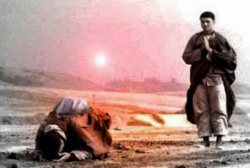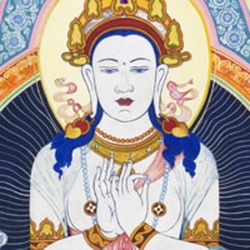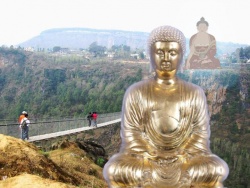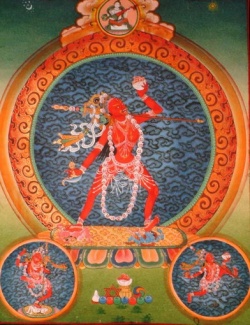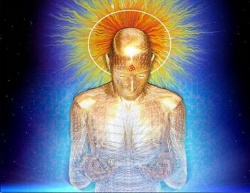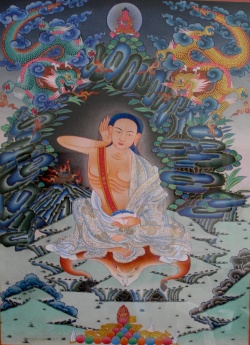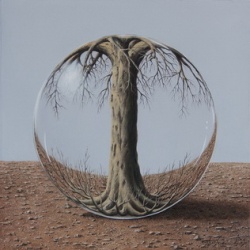Western Buddhist Teachers By Andrew Rawlinson
By Andrew Rawlinson
formerly Lecturer in Buddhism
University of Lancaster, England
rawlinso@wanadoo.fr
Introduction
The West contains more kinds of Buddhism than has ever existed in any other place. The reason for this is simple: the West discovered Buddhism (and in fact all Eastern traditions) at a time when modern communications and transport effectively made the West a single entity. Previously, Buddhism (and all Eastern traditions) had developed in relative isolation from each other. In principle, there is no reason why we could not find every Buddhist tradition in Tokyo, or Bangkok. But we do not. And again the reason is simple: Eastern Buddhist traditions were not looking outside themselves for a different kind of Buddhism. The West, on the other hand, was prepared to try anything. So the West is the only "open" direction that Eastern traditions can take. But when they do, they are inevitably subjected to the Western way of doing things: crossing boundaries and redefining them. What was originally separate is being unified; what was originally unified is being expanded and diversified.
And it is Western Buddhist teachers who are doing this. Of course, there have been, and still are, excellent Eastern teachers who have adapted to the special conditions that they found in the West. But Eastern teachers, however good they might be, are bound to remain Eastern; we might even say "foreign," to some extent. A culture needs people from within, so to speak, in order to make any import its own. And the inverse of this principle also holds: Westerners, however good they are, have to learn Buddhism from the "outside." This creates difficulties of its own. Yet the fact remains that there are Western Buddhist teachers who are transmitting the Dharma in a way that is quite as authentic as that of Eastern teachers (even more so in some cases). So much for general principles. Now for some specific examples.
Historical Issues
Historically, the discovery of Theravāda, Zen, and Tibetan Buddhism were all very different from each other. For example, Eastern Theravādins — Sri Lankan, Burmese, or Thai — simply did not come to the West. The only real exception was Anagarika Dharmapala, a remarkable man (who attended the World Parliament of Religions in Chicago in 1893 and visited the West several times after that), but quite untypical of the tradition that he represented. Not only was he a Theosophical Buddhist but a Theosophist before (in both senses of the term) he was a Buddhist. In effect, he was an honorary Westerner. There's nothing wrong with that, but such an approach was very far removed from the way everyone else was practicing Theravāda in Sri Lanka at the time. Actually, Eastern practitioners, and particularly Eastern monks, made next to no contribution to the Western understanding of Theravāda. (And the first Theravādin monk ever to come to the West was an Englishman: Allan Bennett/Ananda Maitreya, who was ordained in Burma in 1902 and visited England in 1908. This is very odd when you think about it.) Westerners did everything: they translated the texts — the Pali Text Society was founded in 1881 — and wrote books about "Buddhism" (a term that Westerners invented; Eastern Buddhists followed the Dharma or the Buddhadharma).
Zen was the opposite of all this: Japanese teachers did come to the West. The first, Sōen Shaku, was the abbot of a monastery, no less. And they stayed. Not in large numbers and only in the United States, but they were there. And they were the source of the tradition. There were no translations of Japanese classics by anyone, Japanese or Western. The first exposition of Zen was D. T. Suzuki's Essays in Zen Buddhism (first volume in 1927), which was a great work but not actually connected with Zen as the Japanese teachers in the States were teaching it (and this despite the fact that Suzuki was a lay disciple of Sōen Shaku). Sokei-an Sasaki, a disciple of a disciple of Sōen Shaku, said that five minutes' practice was too much for most of his American students.(1) This is worlds away from Zen in Japan at that time. And all of this is happening over thirty years after Anagarika Dharmapala introduced Theravāda to the West and nearly half a century after Pāli texts began to be translated by Western scholars.
Tibetan Buddhism took even longer to establish itself in the West. Contact between Tibet and the West was practically non-existent. Tibetans never came to Western countries, and the Westerners who went to Tibet or Tibetan-influenced areas like Sikkim were few and far between. Various pioneers — scholars, missionaries, explorers, and adventurers — did manage it and produced assorted works, all of them interesting in their own way. A few of them were Buddhists of diverse persuasions: Alexandra David-Néel, W. Y. Evans-Wentz, Lama Anagarika Govinda. I have a high regard for all three. But none of them really represented the tradition.
Given these extremely diverse histories, how were Theravāda, Zen, and Tibetan Buddhism transmitted to the West? As one would expect, in very different ways. Westerners joined the Theravādin sangha as monks in Burma and Sri Lanka at the turn of the century, and while this only constitutes a handful, it's true, some of them stayed for decades.(2) In contrast, the first Westerners to go to Japan to live and practice for any length of time did not do so until after World War Two,(3) a difference of nearly fifty years. And of course, Westerners could not practice Tibetan Buddhism in any numbers until the Tibetans themselves came to the West at the beginning of the 1960s. Even now, the vast majority of Western practitioners remain in the West. Some go to India; none go to Tibet.
The significant thing, given these divergent scenarios, is that Westerners now occupy more or less every position of authority and importance in all three traditions, and have created a few of their own as well.
Theravāda Teachers
Western Theravāda, for example, has two different kinds of sangha, or community. First, there is the traditional community of monks, the bhikkhu sangha. The largest is in England: Amaravati, established in 1979 by Ajahn Sumedho, an American monk who had previously spent ten years as a monk in Thailand. Amaravati follows the way of life of the forest monks of Thailand, which is itself based on the Vinaya. Theravādin monks regard the Vinaya as a spiritual practice, one that applies to every moment of their lives. They are not against specific meditational practices such as vipassanā, and many of them practice it; but it is not their main focus.
But it is for the vipassanā sangha, of course. It is a nice coincidence that four of the earliest Western vipassanā teachers — Joseph Goldstein, Jack Kornfield, Jacqueline Mandell, and Sharon Salzberg (listed in strict alphabetical order) — were appointed as teachers by the Burmese vipassanā teacher, Mahāsi Sayādaw, in 1979, the same year that Amaravati, the first Western bhikkhu sangha, was established.
The two Western Theravādin sanghas — bhikkhu and vipassanā — overlap to a large extent; they are both Theravaadin, after all. Even so, there are considerable differences between them. The vipassanā sangha is essentially a lay community and not monk-oriented; it is firmly based on vipassanā meditation rather than the Vinaya of the bhikkhu sangha; and it allows the possibility that vipassanā can lead to enlightenment — for anybody, Eastern or Western, male or female,(4) ordained or lay — here and now. (There has even been the suggestion, quietly voiced, that some vipassanā teachers may have attained nibbāna.)
Zen Teachers
Zen also has its communities or sanghas, but unlike Theravāda, it is based on lineages of Dharma transmission.(5) There are scores of these lineages, perhaps hundreds. And Westerners have entered them, received transmission from their Japanese teachers and in turn given Dharma transmission to their own Western students. So there are now Western Dharma lineages. The one at the San Francisco Zen Center (SFZC) goes back to Shunryū Suzuki, who gave Dharma transmission to his son Hoitsu Suzuki (in 1963) and then to Richard Baker (in 1971). That is, they both became his Dharma heirs. And both of them have given Dharma transmission to a number of Americans, who have themselves appointed a number of Dharma heirs (all Western so far), often with own temples and/or centers that are outreaches of SFZC. What all this comes down to is a complete network of Western Zen communities, going back nearly thirty years to Shunryū Suzuki and SFZC, each with its own Western teacher.
And there are others: Robert Aitken's Diamond Sangha; the Dharma lineages that are derived from Philip Kapleau (who was authorized to teach by Yasutani Rōshi); the White Plum Sangha, consisting of the Western Dharma heirs — at least a dozen — of Taizan Maezumi Rōshi; the Order of Buddhist Contemplatives founded by Jiyu Kennett in 1975; and various Rinzai lineages, all of which trace their descent from Sōen Shaku.(6)
These Western Zen lineages are very varied: they take in many nationalities(7) and include women (far more, in proportion to the total number of practitioners, than in Japan), gays, and even Christian priests and nuns (for which, see below). All of this is typically Western. It is utterly untypical of Japan.
Tibetan Teachers
Tibetan Buddhism has a strong monastic tradition, and there are Western monks and nuns, Western lamas, and Western Dharma regents (those who hold the fort, so to speak, in the period between a Tibetan tulku's death and the time, after his discovery as a child, when he is old enough to take on his spiritual responsibilities again).
For example, Freda Bedi, who was ordained as a "srāma.nerikā"(8) by the Karmapa in 1966, was the first Western woman ever to formally enter the Tibetan sangha. She then went on, in 1972, to take full bhik.su.nī vows in the Chinese Mahāyāna tradition. Again this was a first: she was the first woman of any nationality in the Tibetan tradition to do so. (In my opinion, the chances of a Tibetan or a woman from some other Eastern country doing so at that time were more or less zero.)
Then there is Lama Ole Nydahl, who was appointed as a teacher by the sixteenth Karmapa and has a letter authorizing him to use the title "lama."(9) Information about him can be accessed from his website, http://diamondway-buddhism.org, where he is listed as twenty-eighth in the Transmission Lineage of Phowa practice. His immediate predecessor was the highly respected Dilgo Khyentse Rinpoche (who died in 1991), and past lineage holders include Trisong Detsen, King of Tibet (d. 858), and Yeshe Tsogyal Guru, who was a close disciple of Padmasambhava (regarded by all Tibetans as a second Buddha). This is illustrious company.
The only two Western Dharma regents I know of are Ngakpa Jampa Thaye and Ösel Tendzin. The former was appointed by his teacher, Karma Thinley Rinpoche, in 1977 and gives Vajrayāna initiations to his own students; the latter, who was appointed by his teacher, Chögyam Trungpa Rinpoche, in 1976, died of AIDS in 1990, just three years after Trungpa's death and two years before Trungpa's reincarnation, the twelfth Trungpa, was discovered.
Finally, I should mention Dhyani Ywahoo, a Tsalagi/Cherokee, whose teachings have been recognized as in accord with Tibetan Buddhism by two respected Tibetan teachers, Dudjom Rinpoche and Drikung Kyabgon Chekung Rinpoche. Yet she was giving them before she even knew that Tibetan Buddhism existed. (Compare Jetsunma Ahkön Lhamo, the American tulku, below.)
All of these individuals — from Bedi to Ywahoo — have their own significance. But the Tibetan tradition rests foursquare on the tulku principle: that certain individuals are really incarnations of Dharmic qualities and that they manifest these qualities by their mere presence. And there are Western tulkus, that is, those who have been recognized as such by Tibetan teachers. This shows that Westerners really are operating at the heart of the tradition.
The first Western tulkus were actually only half-Western: the sons of Tibetans who had married Western women.(10) But there are presently about a dozen or so tulkus who are completely Western. The best-known are probably Lama Osel, who is Spanish, and the American woman, Jetsunma Ahkön Lhamo. They were both recognized in 1987, but the circumstances of their recognition could hardly have been more different. Lama Osel's parents were students practicing in the tradition. In fact, their teacher, Lama Yeshe, was recognized (first by Lama Zopa, Lama Yeshe's principal Tibetan student and himself a tulku, and finally by the Dalai Lama) as having reincarnated as their son. This is about as "official" as you can get. Jetsunma, on the other hand, had no contact with Tibetan Buddhism at all. She was teaching a meditation group in Washington, D.C., thirty-nine years old and the mother of three children, when she made contact with a Tibetan teacher, Penor Rinpoche, who subsequently recognized her as the incarnation of the "original" Ahkön Norbu Lhamo, a prominent woman teacher of the seventeenth century. Of course, adult tulkus are unheard of in Tibet; it just never happens. Yet as Penor Rinpoche said, "We cannot say for sure who is going to be a tulku. They return only where they are needed. And they have the freedom to take any form they want."(11) In short, the tradition has simply changed its boundaries a little bit and accommodated the Western "presence." (And to reiterate a point I have already made: the West is the only "open" direction for Eastern traditions. So there are no Eastern tulkus, that is, tulkus from countries other than Tibet, even those that have been Buddhist for centuries. In fact, there are hardly any Eastern practitioners — non-Tibetan, that is — at all.)
To summarize what I've said about the three traditions so far: For various historical, geographical, and cultural reasons, they were discovered, and Westerners entered them, in different ways. Yet Westerners genuinely represent all of them. That is, Westerners have been accepted into, and given responsibilities in, each tradition. But all this, from the first tentative seeds to the present flowering, has happened in one "place" and is therefore unlike Eastern Buddhism, where the different traditions were separate and unconnected. (I mean, they didn't even know that the others existed.)
Western Innovations
Bearing all this in mind, we can now go on to three Western innovations. The first is the most obvious: that Western teachers have adapted the traditions to Western culture. Some of these changes have been quite radical. Rōshi Kennett claimed to have had visionary encounters with celestial Buddhas and Bodhisattvas in a state that she called the third kenshō, which is otherwise unknown to the Zen tradition.(12)
Then there is Bernard Glassman, Maezumi Rōshi's first Western Dharma heir (and himself a rōshi). He wanted to make Zen thoroughly American and did so by setting up a Zen business. According to Glassman, "When Zen was introduced in Japan, its inherent cultural context was art—aesthetics . . . In our culture it seems correct to me that business is the world we most associate with."(13) Several years ago, he went in another direction: onto the streets. His Peacemaker Order trains its members by sending them out without money, food or identification papers, all the time asking themselves the question, "Who am I?" He calls this a homeless sesshin. And in response to the charge, "But is it Zen?" Glassman replies: "All the things that people say are not Zen are the things that I want to get involved with."(14)
Secondly, Western teachers have adapted to the fact that there are several Buddhist traditions, and that they are just around the corner, so to speak. (There are more kinds of Buddhism in Los Angeles, London, and Paris than there are in any Eastern city.) One indication of this is what might be called Buddhist ecumenicism. In 1991, Ajahn Sumedho was asked to be the upajjhāya or preceptor in charge of the ordinations — seven men and forty-five women, all of them Eastern apart from one American man — at Hsüan Hua's centre in California because Hsüan Hua himself was too ill. This was probably a first in the Buddhist tradition: a Theravādin monk presiding over an ordination ceremony (of Chinese, and using a different Vinaya, the Dharmaguptaka) in the Chinese tradition. And though, of course, it needed Hsüan Hua's encouragement, it was no accident in my opinion that it happened in the West (with a Westerner doing the honors).
On a slightly different tack, some Western teachers have actually changed traditions within Buddhism. Lama Anagarika Govinda started off as a Theravādin monk as a member of Nyanatiloka's Island Hermitage in Sri Lanka before entering the Tibetan tradition. Rōshi Gesshin Prabhasa Dharma left the Japanese Rinzai tradition and went over to the Vietnamese tradition. Miao Kwang Sudharma has been formally ordained in three traditions: Sōtō Zen, Theravāda, and Chinese Mahāyāna.(15)
But the strongest example of crossing boundaries between Buddhist traditions is what I call the ecumenical sangha (which is different from Buddhist ecumenicism, mentioned above): a movement that wants to make available all those teachings and practices that are "Buddhist." Ven. Martha Dharmapali, for example, who is American, is trying to establish a Women's Dharma Monastery that is not tied to any one tradition. Perhaps the best-known ecumenical sangha is Sangharakshita's Friends of the Western Buddhist Order (FWBO), a specially created sangha that incorporates elements from all the main Buddhist traditions. According to Sangharakshita, "The FWBO . . . does not confuse Buddhism with any of its Eastern cultural forms . . . It is just Buddhist. At the same time it does not reject any of the sects or schools that have arisen in the course of the long history of Buddhism. It appreciates them all and seeks to learn from them all, taking from them whatever it can find that contributes to the spiritual development of the individual in the West."(16) This ecumenical movement — including the whole movement and not just the FWBO — only exists in the West. Eastern Buddhists may join it, but if they do, they will be following a Western lead, a Western Buddhist lead.
Lastly, Western Buddhist teachers have adapted to the presence of several different spiritual traditions, both Eastern (Hinduism, Sufism) and Western (Christianity, Judaism). Some, like Bernard Glassman and Lama Denis Teundroup, have engaged in dialogue with other traditions. Glassman has a non-denominational zendō together with an interfaith service hall at his Zen Center of New York.(17) Classes are held in other Buddhist traditions than Zen, as well as Christianity and Judaism, in which the Old and New Testaments, and Kabbalistic texts are used. On top of that, Glassman has given Dharma transmission to Father Robert Kennedy, a Catholic priest,(18) and to a rabbi, Donald Singer. Teundroup follows a policy of open-minded inquiry, which ranges from the similar-ities between Buddhism and science to the connections with other religions. For example, Arnaud Desjardins, another Frenchman who was formerly associated with Tibetan Buddhism but has since become the disciple of an Indian Vedānta master, regularly goes to Karma Ling, Lama Teundroup's center in France, for dialogues on Buddhism and Vedaanta.
A particular example of this "cross-traditional" tendency is Christian Zen. By that I do not just mean Western Christians who have practiced Zen but those who are, first, Fathers or Sisters or Reverends, and second, have been formally authorized by a Zen teacher to teach Zen themselves. That is, they are "accredited" teachers in both traditions.
Most of these Christian Zen teachers are students of Ko'un Yamada Rōshi (not to be confused with Mumon Yamada Rōshi). He trained a number of Catholic priests and nuns (four of each) of various nationalities. One of them, Father Jäger, who is German, told an "International Buddhist Christian Conference" in Berkeley in 1987: "Many can argue whether a Christian can validly do Zen or teach Zen, or not. The fact is, I am doing it."(19)
This "Yamada Zen-Christian lineage,"(20) is wide-ranging, international, and gives women equal status with men. Ruben Habito (one of the "Yamada Christians") wrote an In Memoriam of his teacher which was entitled, "No Longer Buddhist nor Christian."(21) In it, he said that Yamada Rōshi's whole approach "calls for a reordering of our stereotyped notions of Zen, of Buddhism, and of Christ-ianity."(22)
Finally, there are a number of Westerners who, having started off within one of the traditions, have ended up by declaring themselves independent of Buddhism. What this means varies in each case. Jacqueline Mandell, for example, left the Theravādin tradition, having committed herself to it over many years, because it discriminates against women. "I don't represent anyone," she now says.(23) And Toni Packer, who started off as Philip Kapleau's principal student, has adopted a method of "open inquiry." "I don't call this work 'Zen' anymore, because the word is extra, unnecessary to the inquiry."(24) In fact, she questions whether the word "Buddhist" is of much value. This is a radical position and it leads me to my conclusion.
Conclusion
Western Buddhism is so varied because it crosses boundaries. It includes every kind of formal appointment (monks, nuns, priests, and abbots in the Sri Lankan, Burmese, Thai, Japanese, Tibetan, Korean, and Vietnamese traditions) plus more or less all the special titles that are limited to just one tradition (ajahn in Thai Theravāda; sensei and rōshi in Japanese Zen; lama and tulku in Tibetan Buddhism). In addition, Western teachers in all the traditions have made various claims to have verified the Dharma (however their tradition interprets it) for themselves — usually by spiritual practice. And again, every tradition has its favored practice: vipassanā meditation, zazen, kōan practice, visualization — to name only the best known and most traditional.
On top of that, a large percentage of Western teachers have introduced new elements into their teaching and into their practice, sometimes from other Buddhist traditions; sometimes from other traditions altogether; and sometimes from their own experience. In fact, some of them have reinterpreted their tradition in the light of these extra elements, even to the point of trying to restructure the tradition entirely.
As a result of all these factors — each of which is associated with Western teachers — Western Buddhism is coming up with something new. Why? Because it exists in a larger context of spiritual possibilities: worlds that are expanding and beginning to overlap and influence each other. Westerners are simultaneously at the heart of the various Buddhist traditions and also extending them. This is not to say that the quality of Western Buddhism is uniformly high. But it is an entity in its own right, connected to, but not dependent on, its Eastern parents. Western Buddhism is its own tradition now.
Notes
(1) Charles S. Prebish, American Buddhism (North Scituate, MA: Duxbury Press, 1979), 8.
(2) The Englishman, Allan Bennett/Ananda Maitreya, was ordained in 1902; the German, Anton Gueth/Nyanatiloka Thera, in 1904. Nyanatiloka founded the Island Hermitage for Western monks in Sri Lanka in 1911, and a number of Germans or German-speakers followed him there.
(3) Ruth Fuller Sasaki in 1949. She was ordained a Rinzai priest in 1958; Walter Nowick in 1950; Philip Kapleau in 1953. All of these stayed for 10 years or so. Westerners had practiced in Japan some twenty years earlier, e.g., Dwight Goddard in 1928; Miriam Salanave in 1929; Ruth Fuller Sasaki (then Ruth Fuller Everett) in 1930, but for a few months at most.
(4) It is no accident that the vipassanā sangha contains a relatively high proportion of women teachers. Some of them, like Ruth Denison, have mainly women students, some of them lesbian. Needless to say, this does not happen in the East. The position of women in Theravāda has been a contentious issue in the West. The nuns' (or bhikkhunī) sangha died out in the East many centuries ago and has never been revived. However, there is presently a movement to restore it. Should this be accomplished, it would be one of the most significant developments in any Buddhist tradition for centuries. And it will certainly be the result of Western influence: mainly Western women, though Eastern women and Western men (including some monks but very few Eastern men and hardly any Eastern monks) are part of it. In short, it is a Western movement. This is interesting in itself, but even more so if we see it, as we should, advancing side by side with the vipassanā sangha, where women already have a significant status.
(5) More accurately, this is unlike the bhikkhunī sangha but quite like the vipassanā sangha. The reason for this similarity between Zen and vipassanā is that both are primarily concerned with inner states. Hence there is considerable emphasis on teachers who have attained these states, which are "preserved," so to speak, by a "master" appointing a successor as a sort of guarantee that the inner state is still available.
(6) Details of the Western lineages that go back to Shunryū Suzuki, Taizan Maezumi, and Sōen Shaku can be found in Lineage Trees 1, 4, and 6 respectively in my The Book of Enlightened Masters (Chicago: Open Court, 1997).
(7) Dennis Merzel, for example, one of Maezumi Rōshi's Dharma heirs in the White Plum Sangha, is American, and has given Dharma transmission to students who are French, English, and Dutch. The "Eastern" equivalent would be for a Vietnamese Dharma heir to give transmission to a Thai, a Burmese, and an Indian. Not very likely.
(8) This is as far as the Tibetan tradition goes since it has never had a full bhik.su.nī ordination. As such, strictly speaking, there are no nuns/bhik.su.nī in the Tibetan tradition.
(9) Lama Anagarika Govinda's title, on the other hand, appears to have been conferred on him by his students. This is not to undermine him, or them. But there is a difference.
(10) For example, two of the sons of Chögyam Trungpa (who are half-British): Tendzin Lhawang Mukpo and Gesar Arthur Mukpo, born in America in 1971 and 1973 respectively, and both recognized by the sixteenth Karmapa when they were still little children. These were the first tulkus to be born in the West and also the first who could be called Western (and they were fairly Western, having been educated in Western public schools and not Tibetan monasteries). All previous tulkus had been Tibetan or Mongolian.
(11) See Vajradhatu Sun 11, no. 1 (October-November 1988), 5.
(12) See, however, my entry on her in The Book of Enlightened Masters (363-371), where one of her senior students details the evidence that it is known in Zen.
(13) Helen Tworkov, Zen in America: Five Teachers and the Search for an American Buddhism (New York: Kodansha International, 1994), 121.
(14) Ibid., 151. There have also been what might be called "intellectual" adaptations. Nanavira, an English Theravādin monk, who entered the bhikkhu sangha in Sri Lanka in 1950 and spent the rest of his life there as a practicing monk, had a low opinion of the Theravādin commentarial tradition, and regarded Kierkegaard, Heidegger, Nietzsche, Camus, Sartre, Dostoevski, Kafka, and Joyce as closer to the Buddha's teaching than Buddhaghosa's Visuddhimagga.
(15) Compare this to Robert Clifton (1903-1963), an American who began in the Pure Land tradition, and then went into the Theravādin, Zen, and Tibetan traditions (though in varying degrees and to different depths). He also founded a Western Buddhist Order (in 1951), which was open to any ordained Buddhist of any tradition.
(16) Sangharakshita, New Currents in Western Buddhism: the Inner Meaning of the Friends of the Western Buddhist Order (Glasgow: Windhorse Publications, 1990), 63.
(17) In the same vein, an Interfaith Conference (which included a service attended by Christians and Hindus as well as Zen Buddhists) was held at Amaravati in 1994.
(18) Kennedy has in his turn given transmission to a Catholic nun, Janet Richardson.
(19) Ruben Habito, "In Memoriam: Yamada Koun Roshi ('No Longer Buddhist Nor Christian')," Buddhist-Christian Studies 10 (1990), 23. Of course, not everyone agrees. Philip Kapleau, for instance, who was taught by Yasutani Rōshi, Yamada Rōshi's own teacher, regards Christian Zen as a threat to the integrity of the Zen tradition (See "Life with a Capital 'L': An interview with Philip Kapleau Roshi," Tricycle: The Buddhist Review 2, no. 4 (Summer 1993), 54-61).
(20) There are also a handful of Christian Zen teachers who are priests/nuns but not connected with Yamada Rōshi. I mention them briefly in my entry on Father Hugo Enomiya-Lassalle (and Christian Zen) in The Book of Enlightened Masters (256-61).
(21) See Habito, "In Memoriam." Compare Karlfried Graf Dürckheim (1896-1988), who taught Zen, but did not call it that. He says that what he teaches is not Buddhist, but neither is it non-Buddhist. And equally, it is not Christian but neither is it non-Christian. Hence when he teaches silent sitting/zazen to Christian monks, he does not see it as an exercise in crossing religious boundaries but of going beyond all boundaries. "Human beings can experience Being not because they are Buddhist or Christian but because they are human" (Karlfried Graf Dürckheim, Le Centre d'Etre [[[Wikipedia:Paris|Paris]]: Albin Michel, 1992], 31). In this respect, at least, Dürckheim and Yamada Rōshi are essentially teaching the same thing. Yet I am not aware that there was any contact between them.
(22) I should also mention Rōshi Kennett again in this context of Christian Zen. (She had no connection with Yamada Rōshi.) She regarded Zen as a religion (see Lenore Friedman, Meetings with Remarkable Women [Boston: Shambhala, 1987], 168) and tended to translate it into theistic terms. For example: "Meditation has nothing whatever to do with self-improvement. It is an extra-ordinarily deep, prayerful experience, and its purpose is to become one with the Cosmic Buddha — or, if you like, have an experience of God" (Friedman, Meetings with Remarkable Women, 164). She also referred to the Cosmic Buddha as "the Lord."
(23) Friedman, Meetings with Remarkable Women, 259.
(24) See Toni Packer, The Work of This Moment (Boston: Shambhala, 1990), 50.


